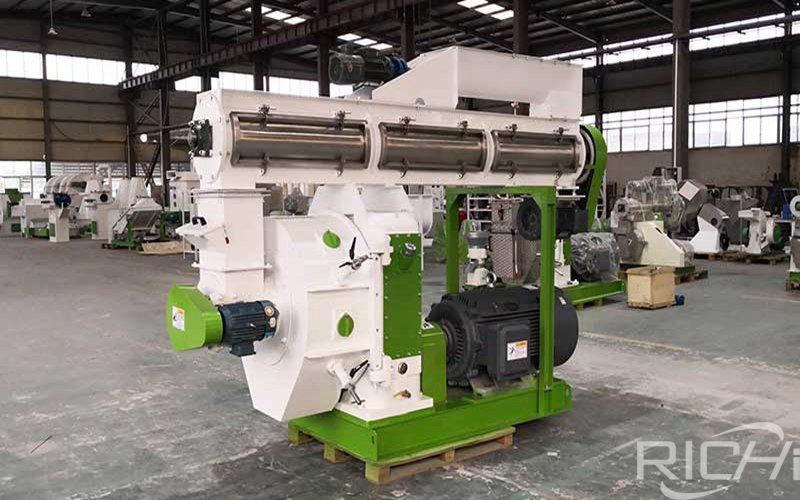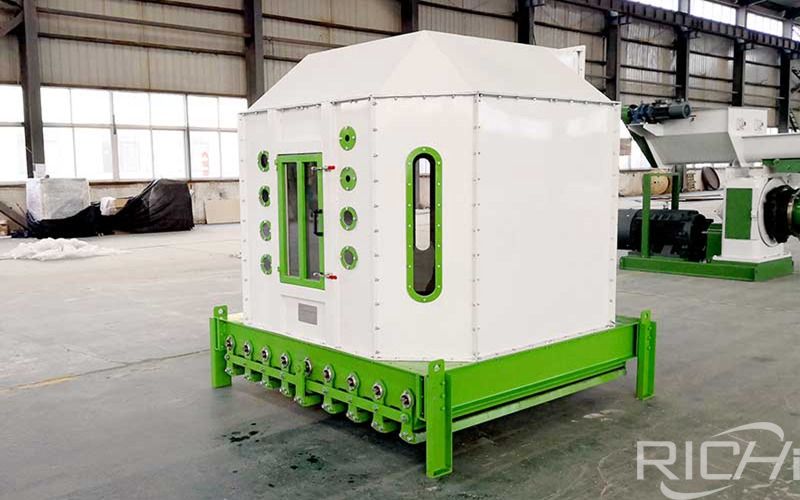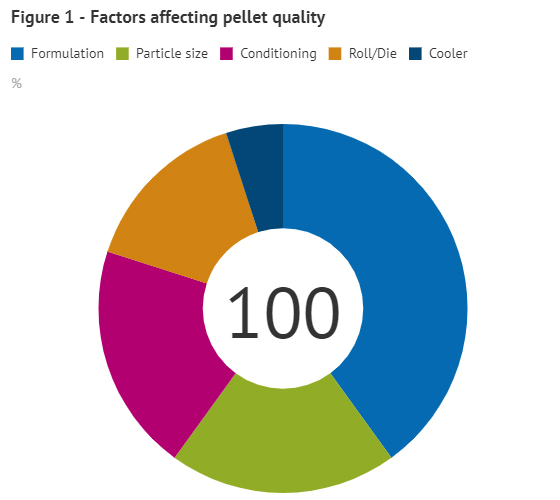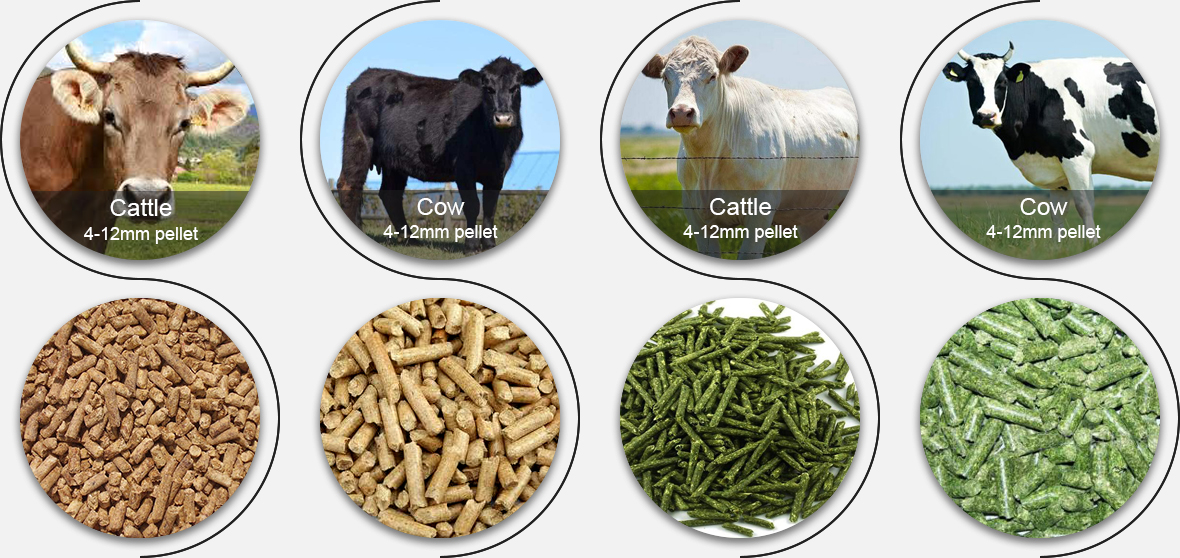
This is where you find all our press releases and news articles.
Several factors have an effect on the quality of the pellets. First of all the feed formulation (raw materials and additives used). Some feed ingredients have a good impact on pellet quality, while others could adversely affect the quality. Unfortunately, corn-soy diets are not the ideal diets to achieve the desired pellet quality. Dietary inclusion of wheat grain or wheat by products (wheat midds, wheat gluten) can increase pellet durability, because of the high protein (gluten) and hemi-cellulose content of wheat in comparison to corn or corn co-products. Similarly inclusion of oat as a partial substitute of corn can increase pellet quality.

Factors Affecting Pellet Quality of Cattle Feed Making Machine
We can rank feed grains according to their positive impacts on pellet quality from best to worst as followings:
1. Affect of steam on pellet quality
Processing obviously has a large effect on pellet quality as well. When mash feed passes through the conditioner, it is exposed to high pressure steam. This steam provides the heat and moisture required for starch gelatinisation, particles adhesion, feed semi-digestion, and feed pathogens damage. The steam temperature and the time that mash feed stays in the conditioner have major influence on the durability of the produced pellets. Conditioning the feed at a temperature of 80° C is sufficient to produce good quality pellets. The minimum time that feed should stay in the conditioning tube to produce durable pellets is 30 seconds. Long time conditioners, in which the feed can stay in the conditioner for about 3-4 minutes, can be used to improve pellet stickiness.
2. Thicker dies have positive impact on pellet durability
Also die/roll specifications should be kept in mind. Pellets are produced via roll pressing of the hot mash against metal die. Thicker dies (long die channels) have a positive impact on pellet durability due to increasing the friction time between feed particles and die wall with subsequent more starch gelatinisation. Most of starch gelatinisation occurs when feed passes through the dies. A similar result can be obtained by using small hole dies. This means that dies of 60 mm thickness are better than those of 50 or 40 mm thickness, and that dies with holes of 3 mm diameter are better than those with holes of 5 mm diameter. However, using thicker or small holes dies have negative impact on pellet throughput. Additionally, increasing the distance between roll and die from 0.1 to 2 mm resulted in an increase in the pellet durability.
3. Affect of ingredient particle size and grinding on pellet quality
The second factor influencing pellet quality is the feed ingredient particle size. Although doubted by some researchers, it is accepted that decreasing ingredient particle size has a good influence on pellet quality. However, over grinding is not recommended to avoid power wastage, reduced production rate and suboptimal gizzard development. On the other hand, coarse grinding eases pellet break down and decreases starch gelatinisation (high degree of gelatinisation is required to produce good pellets).
4. The cooler should be taken into consideration.
After leaving the pellet mill, the temperature of the pellets ranges from 70-90° C and the moisture from 15-17%. Proper cooling (via a stream air cooling machine) is required to lower pellet temperature to about 8° C above the ambient temperature, and moisture % to be 12%. The cooling machine can be either a horizontal or vertical type. Quick cooling leads to removal of more moisture and heat from the surface of the pellets than their core, and the resultant pellets will be brittle. On the other hand, prolonged cooling produces very dry pellets that can be exposed to abrasion and can be of low palatability.

cooler
Pellet quality can be influenced by several factors, including the ingredients, diet formulation and processing. A good rule of thumb is the pellet quality factor (PQF), that each feed ingredient has. The PQF has a score from 0 to 10, where 0 predicts poor pellet quality and 10 good pellet quality. From experience we know that starch and its gelatinisation is the most important factor for achieving the desired pellet quality. However, recent reports indicated that the positive impact of protein on pellet quality is much more important than that of starch.

1. Cereals: maize, barley, oat, wheat, triticale, rye and sorghum
2. Seed from oleaginous crops: soy, flax, and sunflower
3. Seed from legumes: broad beans, field bean and protein pea
4. Forage: flours of permitted forage essences
5. Dried beet pulp.
Furthermore, the following substances can be used as appetizers in feed pellets:
1. Carob-bean, up to a maximum of 3%;
2. Molasses, up to a maximum of 3%.
Note: for animals in lactation, dry animals, and heifers from the sixth month of pregnancy, maximum daily amount of feed pellets is 2 kg/head/day.

cattle feed pellet
The major operations involved in the production of cattle feed pellets are: raw materials preparation, primary crushing, molasses mixing, fine crushing, pellet making and packaging(optional)
1. Raw and auxiliary materials are first charged into silos and tanks where they are made ready for further processing. They are then processed by primary crusher. Crushed materials are further separated by means of a sieve, and then stored in the assorting tanks according to the kind of raw materials.
2. The raw materials are then mixed by means of a feed mixer. In this process, fatty ingredients are added to the materials in order to raise the nutritional value of the feed. The feed obtained from the mixer is blended with molasses.
3. Assorted animal feed that is crushed into fine particles is further formed into pellets by a cattle feed pellet mill.
Having the right mix of reliable, high-quality pellet machine and pelletizing systems and expert support is essential to your success. Watch how our end-to-end feed pellet plant solutions have helped our customers optimize their performance.
Our customized and future-proofed turnkey pellet plant solutions is designed with you at the core. From vision to reality and beyond, our team stays connected with yours. Giving you peace-of-mind with an expert at your side.

At RICHI, we go beyond project completion. With RICHI Servicee, we’re your dedicated partners in success. Count on us for expert guidance, minimal downtime, and optimized productivity. Choose RICHI for unmatched service and support.



Meet global product demands and quality standards with industry-leading pellet plant design, engineering, equipment, and construction services for pellet processors.


Your Partner Beyond Project Completion
2000+ cases
RICHI is the leading designer, manufacturer and builder of pellet plants in the world, completing over 2000 projects in 140 countries across 6 continents.
Read More
Increase plant productivity, profitability, and safety by integrating high quality equipment into your pellet production line. Over the years, RICHI has become China's top pellet equipment manufacturer. At the same time, RICHI has established valuable partnerships with the world's leading component and raw material manufacturers to bring you the best there is in technology, automation, and efficiency in pelleting plant machinery.

For nearly 30 years, RICHI has been providing best-in-class pellet plant equipment and services to clients across a variety of industries, sizes, and needs. We pride ourselves on the knowledge and skill that each team member possesses – from our technical sales team to our process design engineers. You can count on RICHI Machinery to take your operation to the next level of innovation, quality, and success.
Need help with your pellet manufacturing plant project? Contact us today.
ANIMAL FEED
BIOMASS
WOOD
ORGANIC FERTILIZER
AQUA FEED
CAT LITTER
MUNICIPAL WASTE RECYCLING
SPECIAL PELLET PRODUCTION
RICHI Machinery continues to deliver world class pellet mill equipment, pellet plant engineering and project solutions that add value to our customers in the animal feed, wood waste, agriculture waste, organic fertilizer, cat litter and special pellet products industries. Throughout the years, we RICHI Machinery have built strong brand, becoming industry-leading pellet machine manufacturer. We value integrity, promise quality, and prioritize your success.
Learn MoreWith our expert team, we precisely implement your process engineering requirements in pellet mill and pelletizing plant systems. No matter which industry you’re in – we understand your needs and deliver solutions that meet the highest standards.
At RICHI, quality comes first. Our pellet making machine and related pellet line equipment undergo rigorous quality controls to ensure they meet the highest standards. Rely on products that are durable, safe, and efficient.
With decades of experience in pellet machine and pellet production line production, we have earned a reputation as a trusted partner in various industries. Our expertise allows us to cover a wide range of applications.
Not only do we offer premium pelleting equipment, but we are also experts at designing, building, installing, and maintaining facilities from the ground up. Our expertise is within pellt plant process design, discovering the most efficient, productive, and profitable way to handle your materials in an end-to-end cycle.

Keeping in touch with us is an effective way to solve all your problems. If you have any needs or questions, please leave your contact information, then RICHI technical consultants will send design, quotation, videos to your mailbox. You can also contact us directly via WhatsApp: +86 13838389622
Copyright©2015-2024 by HENAN RICHI MACHINERY CO., LTD. All rights reserved.